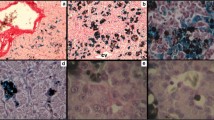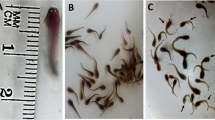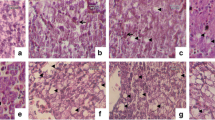Abstract
This study describes the histopathological effects of carbaryl in the spleen of Levantine frog, Pelophylax bedriage. Due to its primary role in immune system, it is important to research the toxic effects of pesticides, which play an important role in environmental pollution, on spleen. To that end, adult frogs were exposed to carbaryl for 96 h. Experimental groups contained low dose, (0.05 mg/g), medium dose (0.1 mg/g) and high dose (0.2 mg/g). After following exposure to carbaryl, the frogs were euthanised and dissected. In low-dose group, there were no important changes in spleen tissue. In medium-dose group, prominence in haemorrhage just below the capsule and an increase in the melanomacrophage number were determined. In high-dose group, in addition to increases in the melanomacrophages, separations in capsule, haemorrhage below capsule and within splenic tissue, sinusoidal enlargement, congestion in dilated sinusoid, hypertrophic plasma cells and fibrosis were determined as important histological lesions in exposed frogs. This study clearly showed that carbaryl caused important histopathological damages in splenic tissue of Pelophylax bedriagae. In view of these findings, it can be said that this insecticide has the capacity to disrupt spleen’ functions.



Similar content being viewed by others
References
Agius C, Roberts RJ (2003) Melano-macrophage centers and their role in fish pathology. J Fish Dis 26:499–509
Ahmed WMS, Moselhy WA, Nabil TM (2015) Bisphenol a toxicity in adult male rats: hematological, biochemical and histopathological approach. Glob Vet 14:228–238
AL-Saffar AH (2008) Studies on haemopoiesis and histological aspects of Rana ridibunda spleen. Kufa Med Journal 11:61–66.
Alford RA, Richards SJ (1999) Global amphibian declines: a problem in applied ecology. Annu Rev Ecol Syst 30:133–165
Alvarez R (1990) An ultrastructural study of the spleen of the ranid frog Rana perezi. J Morphol 204:25–32
Amin OM, Düşen MS, Oğuz MC (2012) Review of the helminth parasites of Turkish anurans (Amphibia). Sci Parasitol 13:1–16
Bacchetta R, Mantecca P, Andrioletti M, Vismara C, Vailati G (2008) Axial-skeletal defects caused by carbaryl in Xenopus laevis embryos. Sci Total Environ 392:110–118
Banaee M, Davoodi MH, Zoheiri F (2013a) Histopathological changes induced by paraquat on some tissues of gourami fish (Trichogaster trichopterus). Open Vet J 3:36–42
Banaee M, Sureda A, Mirvagefei AR, Ahmadi K (2013b) Histopathological alterations induced by diazinon in rainbow trout (Oncorhynchus mykiss). Int J Environ Res 7:735–744
Başkale E, Kaya U (2012) Decline of Levantine frog, Pelophylax bedriagae Camerano, 1882 in the western Agean region of Turkey: changes in population size and implications for conservation. Zool Middle East 57:69–76
Boone MD, Hammond SA, Veldhoen N, Youngquist M, Helbing CC (2013) Specific time of exposure during tadpole development influences biological effects of the insecticide carbaryl in green frogs (Lithobates clamitans). Aquat Toxicol 130–131:139–148
Bridges CM (2000) Long-term effects of pesticide exposure at various life stages of the southern leopard frog (Rana sphenocephala). Arch Environ Contam Toxicol 39:91–96
Çakıcı Ö (2013) Carbaryl-induced histopathologic alterations on testes of Levantine frog, Pelophylax bedriagae (Anura: Ranidae). Bull Environ Contam Toxicol 91:96–101
Çakıcı Ö (2014) Carbaryl-induced histopathologic alterations on digestive tract of the Levantine frog, Pelophylax bedriagae (Anura: Ranidae). Toxicol Pathol 42:1032–1040
Çakıcı Ö (2015) Histopathologic changes in liver and kidney tissues induced by carbaryl in Bufotes variabilis (Anura: Bufonidae). Exp Toxicol Pathol 67:237–243
Çakıcı Ö (2016) Histopathological study of toxic effects of carbaryl on digestive tract of Bufotes variabilis (Anura: Bufonidae). Environ Sci Pollut Res 23:13432–13437
Christine MS, Menard L, Giroux I, Marcogliese DJ, Ruby S, Cyr D, Fournier M, Brousseau P (2013) Effects of agricultural pesticides on the health of Rana pipiens frog from the field. Environ Sci Pollut Res 20:601–611
David M, Kartheek RM (2015) Histopathological alterations in spleen of freshwater fish Cyprinus carpio exposed to sublethal concentration of sodium cyanide. Open Vet J 5:1–5
Davidson C (2004) Declining downwind: amphibian population declines in California and historical pesticides use. Ecol Appl 14:1892–1902
Davidson C, Benard MF, Shaffer HB, Parker JM, O’leary C, Conlon JM, Rollins-Smith LA (2007) Effects of chytrid and carbaryl exposure on survival, growth and skin peptide defenses in foothill yellow-legged frogs. Environ Sci Technol 41:1771–1776
Delen N, Durmusoglu E, Guncan A, Gungor N, Turgut C, Burcak A (2005) Turkey Agricultural Engineering 6. Technical Congress. Ankara, Turkey. pp 1–21
Distel CA, Boone MD (2009) Effects of aquatic exposure to the insecticide carbaryl and density on aquatic and terrestrial growth and survival in American toads. Environ Toxicol Chem 28:1963–1969
Dulak J (1990) The architecture of the spleen of the yellow-bellied toad, Bombina variegata. J Zool 221:489–498
Dulak J, Bauer J, Döpp EA, Van Rooijen N (1993) Immun-complex-trapping cells in the spleen of the oriental fire-bellied toad, Bombina orientalis. Cell Tissue Res 271:155–158
DuRant SE, Hopkins WA, Talent LG (2007) Impaired terrestrial and arboreal locomotor performance in the western fence lizard (Sceloporus occidentalis) after exposure to an AChE-inhibiting pesticide. Environ Pollut 149:18–24
El-Bendary HM, Shaker MH, Saleh AA, Negm SE, Khadey ME, Hosam Eldeen FA (2014) Histopathological changes associated with exposure of male mice to profenofos and chlorpyrifos. Annu Res Rev Biol 4:766–777
EPA (2003) Interim reregistration eligibility decision for carbaryl. Case 0080. Washington, DC
EPA (2004) Carbaryl ınterim reregistration eligibility decision (IRED) facts. EPA, Office of Pesticide Programs, pp 1–318
Fair JM, Kennedy PL, McEwen LC (1995) Effects of carbaryl grasshopper control on nesting killdeer in North Dakota. Environ Toxicol Chem 14:881–890
Ferrari A, Lascano C, Pechen de D’Angelo AM, Venturino A (2011) Effects of azinphos methyl and carbaryl on Rhinella arenarum larvae esterases and antioxidant enzymes. Comp Biochem Physiol C 153:34–39
Franco-Belussi L, De Oliveira C (2016) The spleen of Physalaemus nattereri (Amphibia: Anura): morphology, melanomacrophage pigment compounds and responses to α-melanocyte stimulating hormone. Ital J Zool 83:298–305
Garber K, Jones RD, Steeger T (2007) Risks of carbaryl use to the federally-listed California red-legged frog (Rana aurora draytonii). Pesticide Effects Determination, Environmental Fate and Effects Division, US Environmental Protection Agency Office of Pesticide Programs, Washington, DC
Grillitsch B, Schiseari L (2010) The ecotoxicology of metals and reptiles. In: Sparling DW, Linder G, Bishop CA, Krest SK (eds) Ecotoxicology of amphibians and reptiles, Second edn. CRC Press, In
Hayes TB, Falso P, Gallipeau S, Stice M (2010) The cause of amphibian declines: a developmental endocrinologist’s perspective. J Exp Biol 213(6):921–933
Jean-Claude A, Amiard-Triquet C (2015) Ecotoxicological risk of endocrine disruptors. In: Aquatic toxicology advancing tools for dealing with emerging risks. In Amiard-Triquet C, Jean-Claude A, Mouneyrac C (eds) Elsevier
Kang HS, Park CJ, Gye MC (2010) Effect of carbaryl on survival and development in Bombina orientalis (Boulenger) embryos. Bull Environ Contam Toxicol 84:550–553
Karim A, Ahmad N, Ali W (2016) Histopathological changes in spleen and kidney of silver carp (Hypophthalmichthys molitrix) after acute exposure to deltamethrin. Biologia 62:139–144
Labenia JS, Baldwin DH, French BL, Davis JW, Scholz NL (2007) Behavioral impairment and increased predation mortality in cutthroat trout exposed to carbaryl. Mar Ecol Prog Ser 329:1–11
Mahmood I, Imadi SR, Shazadi K, Gul A, Hakeem KR (2016) Effects of pesticides on environment. In: Hakeem K, Akhtar M, Abdullah S (eds) Plant, soil and microbes. Springer, Cham, pp 253–269
Malik P (2014) Environmental pollution by pesticides: source and pollution. Int J Innov Res Dev 3(3):242–246
Mebius RE, Kraal G (2005) Structure and function of the spleen. Nat Rev Immunol 5:606–616
Metts BS, Hopkins WA, Nestor JP (2005) Interaction of an insecticide with larval density in pond-breeding salamanders (Ambystoma). Freshw Biol 50:685–696
Mitchkash MG, McPeek T, Boone MD (2014) The effects of 24-h exposure to carbaryl or atrazine on the locomotor performance and overwinter growth and survival of juvenile spotted salamanders (Ambystoma maculatum). Environ Toxicol Chem 33:548–552
Mohany M, Badr G, Refaat I, El-Feki M (2011) Immunological and histological effects of exposure to imidacloprid insecticide in male albino rats. Afr J Pharm Pharmacol 5:2106–2114
Nilsson S (2012) Autonomic nerve function in the vertebrates, vol 13. Springer Science & Business Media, Berlin
Sachar A, Raina S, Gupta K (2013) Histopathological alterations induced by lindane (gamma-hexachlorocyclohexane) in a minor carp, Aspidoparia morar inhabiting Jammu waters. Int J Sci Res Publications 3:74–79
Tiron A, Vasilescu C (2008) Role of spleen in immunity. Immunologic consequences of splenectomy. Chirurgia (Bucur) 103(3):255–263
Toumi H, Bejaoui M, Touaylia S, Burga Perez KF, Ferard JF (2016) Effect of carbaryl (carbamate insecticide) on acetylcholinesterase activity of two strains of Daphnia magna (Crustacea, Cladocera). J Environ Sci Health B 51:777–780
Author information
Authors and Affiliations
Corresponding author
Additional information
Responsible editor: Philippe Garrigues
Rights and permissions
About this article
Cite this article
Çakıcı, Ö. Histopathological analysis of carbaryl-induced toxicity in the spleen of Levantine frog, Pelophylax bedriagae (Anura: Ranidae). Environ Sci Pollut Res 25, 24917–24922 (2018). https://doi.org/10.1007/s11356-018-2538-5
Received:
Accepted:
Published:
Issue Date:
DOI: https://doi.org/10.1007/s11356-018-2538-5




